


The museum, which was the victim of a major burglary in 1987, has recently been re-opened in Palazzo Biancalana. The nucleus of the current collection was formed from material collected by:
-
✴Giuseppe Bianconi, who left his collection of local antiquities to the Commune when he died in 1897; and
-
✴Francesco, Giuseppe and Pio Biancalana, whose property (including Palazzo Biancalana) passed to the Commune after the death of Bianca Biancalana in 1920.
A collection of annotated illustrations (1851) by Pio Biancalana in the Biblioteca Comunale Augusta, Perugia constitutes the most important surviving record of the excavations carried out in Bettona in the early 19th century.
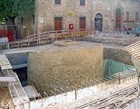
Inscribed cippi (late 3rd or early 2nd century BC)
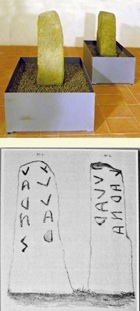
-
✴“tular larna”; and
-
✴“tular larns”.
The word “tular” probably meant boundary and the cippi seem to have marked the boundary of the area in which the “larna” family buried their dead. This name is known from inscriptions from the necropolises of Volsinii (Orvieto), and it could be that the family left Volsinii when it was destroyed in 264 BC.
The museum also exhibits three broadly contemporary funerary cippi from the city on which the Etruscan names of the deceased were inscribed:
-
✴“[a]u casne navc” (PE 1.682)
-
✴“[.....]imial” (PE 1.683); and
-
✴“larθi caia au sec” (PE 1.685).
These inscriptions are also described in the page on Etruscan Inscriptions after 295BC.
Architectural Terracottas (3rd-2nd centuries BC)
Some 200 architectural terracottas were excavated in 1884 at an unspecified location outside Bettona. Objects of this kind were used to decorate wooden temples, and this collection constitutes one of the largest of its kind in Umbria. It is therefore particularly unfortunate that there no surviving record of the exact location of the find site. The terracottas seem mostly to belong to a major restoration of the temple that was carried out after the Social Wars.
A group of votive bronzes (late 6th – early 4th century BC), mainly human figures or representations of body parts, which apparently came from an unknown location in or near Bettona, has also been known since the late 19th century. [Some of these now form part of the Bellucci Collection in the Museo Archeologico, Perugia.] These could have come from the same site and belong to an early phase, before the temple in question was monumentalised.
The most interesting of the terracottas represent:
-
✴afragment of a pair of panthers, which were apparantly hitched to a chariot, and a head from one of them (illustrated); and
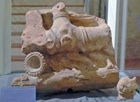
-
✴fragments from a relief of a winged victory driving a chariot.
Funerary Urn (2nd century BC)
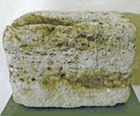
Funerary Inscriptions (3rd and 2nd centuries BC)
The museum exhibits a number of travertine funerary cippi, some of which bear the names of the deceased. Most of these probably came from the necropolis that was excavated at the Fosso del Colle in 1845.
-
✴The Etruscan inscriptions commemorate:
-
•a lady, “laria : caia : au : sec” (late 3rd century BC);
-
•“au casne nav[e]s[i]al” (late 3rd century BC); and
-
•a fragment, “[...]rmial” (late 3rd or early 2nd century BC).
-
✴The archaic Latin inscriptions commemorate:
-
•Aprilia, the daughter of Lucius (CIL XI 5184, late 2nd century BC);
-
•Lucius Apriliu[s] (CIL XI 7981, late 2nd century BC); and
-
•Sextus Tarquitius, son of Caius (CIL XI 5200, late 2nd century BC), which is carved on what seems to be an older cippus (late 3rd century BC) that was apparently found beside the road some 1 km outside Torgiano.
The reason for this precocious use of latin in Bettona is unknown.
Portrait Bust of the Emperor Domitian (ca. 70 AD)
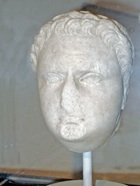
Head of Hercules
This cast is of an original that was stolen in 1987 and has not yet been recovered. The original. which derived from the so-called Farnese Hercules (early 3rd century AD), formed part of the collection of Giuseppe Bianconi.
Inscription in honour of Vespasian (79 AD)
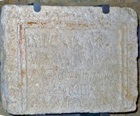
Oscillum (1st century AD)
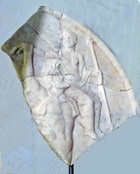
Head of a Woman (2nd or 1st century AD)
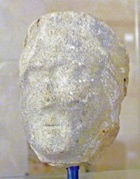
Head of Aphrodite (2nd century AD)
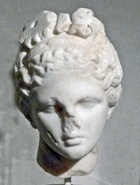
Fragment of a sarcophagus (3rd century AD)
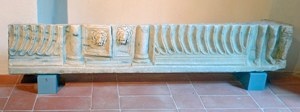
The front of the sarcophagus originally had a pair of doors between columns at its centre, with the left door was slightly open. Each door was made up of square panels decorated with a lion’s head, which were arranged one above the other. Striated panels flanked these doors. At the extreme right, the lower part of the standing figure of a man survives, with his horse apparently grazing on grass to his left.
Deposit of the Museum
Inscription (2nd century AD)
This fragmentary inscription (CIL XI 5181), which was re-used at San Quirico , records a now-anonymous quatuorvir iure dicundo. According to the EDR database, it probably came from Urvinum Hortense (Cannara), where a quattuorviral administration is securely documented.
Read more :
S. Stopponi (Ed), “Museo Comunale di Bettona: Raccolta Archeologico”, Perugia, 2006
Return to Walk I.
Return to Museums of Bettona.

